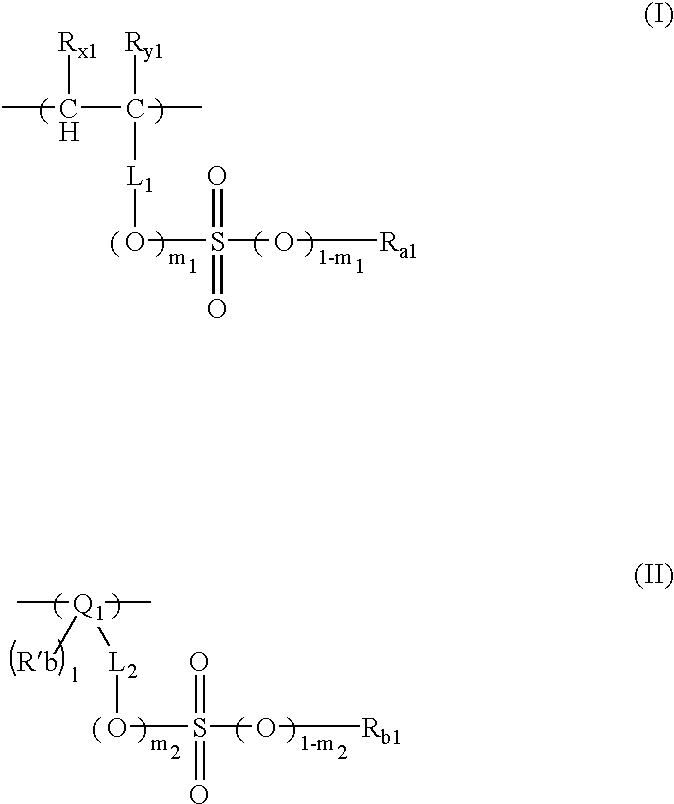Positive resist composition
a composition and resist technology, applied in the field of positive resist compositions, can solve the problems of resist compositions related to the art, resist compositions containing fluorine resins, resist compositions with related art, and resist compositions with fluorine resins, etc., to achieve the effect of positive resist, high sensitivity, and sufficient transparency
- Summary
- Abstract
- Description
- Claims
- Application Information
AI Technical Summary
Benefits of technology
Problems solved by technology
Method used
Image
Examples
examples
[0365]The invention is now described in more detail in the following examples. However, the examples never limit the contents of the invention.
[0366]20 g of triphenylsulfonium iodide was dissolved in 500 ml of methanol, to which 12.5 g of silver oxide was added, for agitation at ambient temperature for 4 hours. After the silver compound was discarded by filtration of the reaction solution, 14.9 g of nonafluorobutanesulfonic acid was added to the resulting solution and was then concentrated. 300 ml of diisopropyl ether was added to the resulting oily matter, for sufficient agitation. Thereafter, diisopropyl ether was removed by decantation. The procedure was repeated two times. The resulting oily matter was dried under reduced pressure, to recover the object compound of 18 g.
[0367]10 g of triphenylsulfonium iodide was dissolved in 500 ml of methanol, to which 4.44 g of silver oxide was added, for agitation at ambient temperature for 4 hours. After the silver compound was discarded by...
synthetic example ii-1 (
Synthesis of F′-1)
[0392]1.24 g of an azo-series polymerization initiator V-65 (manufactured by Wako Pure Chemical Co., Ltd) was added to 2.65 g of the monomer represented by the formula (1), 7.2 g of the monomer represented by the formula (2) and 6.85 g of the monomer represented by the formula (3), while these monomers were agitated in nitrogen atmosphere. The resulting mixture was agitated at 65° C. for one hour as it was, for reaction. 2.65 g of the monomer (1), 7.2 g of the monomer represented by the formula (2), 6.85 g of the monomer represented by the formula (3) and 2.48 g of V-65 (manufactured by Wako Pure Chemical Co., Ltd.) separately prepared were dissolved in 60 g of MEK. The resulting solution was kept at 10° C. and was then dropwise added to the polymerization reaction solution under agitation at 65° C. during reaction, over 4 hours.
[0393]500 ml of hexane was added to the reaction solution to precipitate the polymer. The upper layer was removed by decantation. The rema...
synthesis example iii-2
(Synthesis of Resin (C-1) of Comparative Example)
[0423]10.6 g of the monomer represented by the following general formula (4) was added to 25 g of THF, which was then added to 12.1 g of the monomer represented by the general formula (1). 2.48 g of an azo-series polymerization initiator V-65 (manufactured by Wako Pure Chemical Co., Ltd) was added to the resulting mixture under agitation in nitrogen atmosphere. The resulting mixture was agitated at 65° C. for one hour for reaction, as it was. 500 ml of hexane was added to the reaction solution to precipitate the polymer. The upper layer was removed by decantation. The remaining viscous polymer was dissolved in 50 ml of acetone, to which 1 L of hexane was again added, to separate the polymer and remove the unreactive monomers and oligomer components. The molecular weight of the resulting polymer was measured by GPC. The weight average molecular weight was 5,000, while the dispersion degree was 1.9.
[0424]
PUM
 Login to View More
Login to View More Abstract
Description
Claims
Application Information
 Login to View More
Login to View More - R&D
- Intellectual Property
- Life Sciences
- Materials
- Tech Scout
- Unparalleled Data Quality
- Higher Quality Content
- 60% Fewer Hallucinations
Browse by: Latest US Patents, China's latest patents, Technical Efficacy Thesaurus, Application Domain, Technology Topic, Popular Technical Reports.
© 2025 PatSnap. All rights reserved.Legal|Privacy policy|Modern Slavery Act Transparency Statement|Sitemap|About US| Contact US: help@patsnap.com



